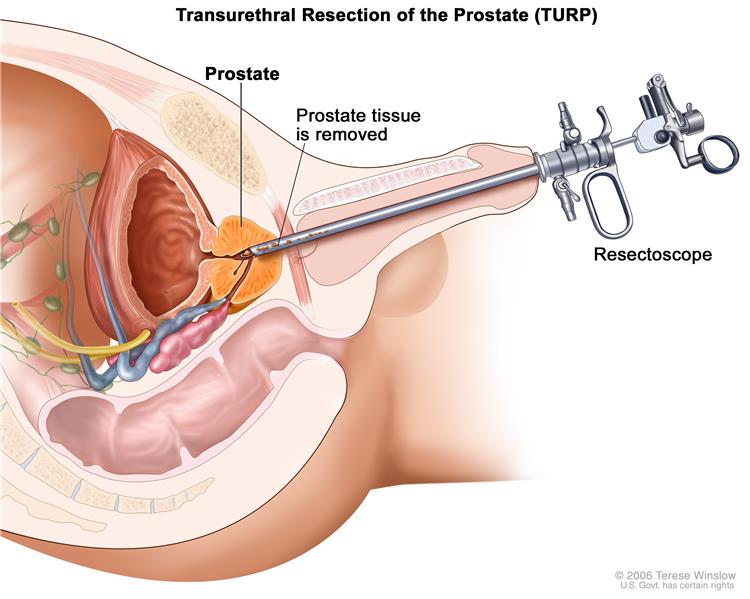


Transurethral Resection of the Prostate (TURP) is a procedure to remove excessive growth of the prostate gland, resulting from Benign Prostatic Hyperplasia (BPH). The prostate gland plays an essential role in the functioning of the male reproductive system, secreting fluid into the urethra during ejaculation. It surrounds the urethra and is located immediately below the neck of the urinary bladder.
Transurethral resection of the prostate (TURP) is a surgery used to treat urinary problems due to an enlargedprostate. A combined visual and surgical instrument (resectoscope) is inserted through the tip of your penis and into the tube that carries urine from your bladder (urethra). The prostate surrounds the urethra.

TURP is an invasive procedure to remove the overgrowth of prostate tissue. Despite the more recent development of less-invasive treatments, TURP is still considered the “gold standard” of prostate surgery options and the preferred treatment for BPH. It is performed by a urologist in a hospital under general anesthesia or spinal anesthesia coupled with a sedative.
A resectoscope (an instrument much like a cystoscope with the advantages of a microscope, light, irrigation capability, and a wire loop) or a spring-action cutting tool, is inserted into the urethra to access the enlarged prostate gland. The electricity generated through the cutting tool removes small pieces of tissue until the urethra is no longer restricted. To control bleeding, the vessels are cauterized by the wire loop and the bladder and urethra are irrigated with a saline solution. A urinary catheter is put in for the purpose of resting the bladder and prostate, keeping the urethra open if swelling develops, and to empty the bladder of blood to avoid clotting. The procedure takes about 90 minutes to two hours.

Recent technological advances to reduce the invasive aspect of surgical treatments of BPH offer options such as lasers, microwave, radio waves, and ultrasound.
Commonly, there is a one-night hospital stay for observation and flushing of the catheter. Light bleeding will continue, presented in the urine and when the catheter is flushed out. The catheter will remain in for a few days to a week and must be flushed regularly by the patient after discharge; instructions on how to do this are given while in the hospital.
After discharge, precautions are recommended for the purpose of healing, comfort, and preventing damage to the treated area. Patients will require rest and should drink large quantities of water to flush out the bladder to prevent a urinary tract infection. No straining, lifting or pushing heavy items should occur. A significant improvement in recovery is seen after the catheter has been removed and, while some of the pre-operative symptoms may continue, they will slowly decrease over a period of two to eight weeks. Complete reversal of all prior symptoms may take several months.
Sexual function returns for most men, but the doctor may advise against ejaculation for up to two months. While the ability to orgasm is unaffected by TURP, your ejaculate may no longer exit through the penis. This occurs if the valve to the bladder, which controls the direction of semen, is damaged during the procedure.
Like any other surgery, there are risks associated with TURP, which include blood clots in the legs that may travel to the lungs, breathing problems, infection in the surgical wound, lungs (pneumonia), or bladder or kidney, blood loss, heart attack or stroke during surgery, and allergic reactions to medication. In addition, there are other problems that may occur as side effects of a TURP. These are problems controling urine, loss of sperm fertility, erectile dysfunction, passing semen into the bladder instead of out through the urethra (retrograde ejaculation), tightening of the urinary outlet from scar tissue (urethral stricture), transurethral resection (TUR) syndrome (water buildup during surgery), or damage to internal organs and structures.
Note: Prostate Cancer News Today is strictly a news and information website about the disease. It does not provide medical advice, diagnosis or treatment. This content is not intended to be a substitute for professional medical advice, diagnosis, or treatment. Always seek the advice of your physician or other qualified health provider with any questions you may have regarding a medical condition.
After a person reaches the age of 40 years old, cells in the prostate gland can sometimes begin to multiply. This growth can lead to enlargement of the gland, causing it to squeeze the urethra, often interfering with urination.
This condition is known as benign prostatic hyperplasia (BPH) or benign prostatic enlargement (BPE). It is not related to cancer and is usually harmless, though it can cause unpleasant symptoms.
The prostate is a walnut-sized reproductive gland responsible for producing some of the fluid components of semen. The fluid combines with sperm from the testicles when it enters the urethra during ejaculation.
The most common surgery for BPH is called transurethral resection of the prostate or TURP. During the procedure, surgeons remove the excess prostate tissue through the urethra.
Most TURP surgeries take between 1 and 2 hours and require several hours recovery under continuous monitoring.
The catheter is usually kept in place for 2 to 3 days after TURP surgeries and removed when the bladder has been completely flushed.
There are several ways to reduce the risk of complications after TURP surgery.Tips for a better recovery include eating a healthful diet, avoiding sexual intercourse for a few weeks, and staying hydrated.